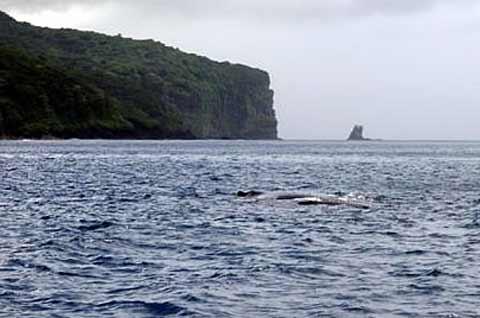For most Americans, September means school's back in session, football is back on the TV and autumn leaves are just a few weeks away. South of the equator, however, it's early spring, and a critical time for humpback whales. According to information from National Park of American Samoa,
Southern hemisphere humpback whales migrate every year to the U.S. Territory of American Samoa during the southern hemisphere spring. They summer in the waters off the coast of Antarctica and come north to the South Pacific islands to give birth.
The adult humpback whale is a federally endangered species, and one was sighted recently by park marine biologists near the shore of Pola Island in the park’s Tutuila Unit. The whale was in approximately 30 feet of water, and the animals typically approach close to shore in such shallow water only when preparing to give birth.
The scientists gave the whale a wide berth as they moved past toward the Pola Island’s east side for a dive. After their dive, they saw a whale approximately 200 feet off the boat, resting on the surface. The scientists drifted toward the whale at idle speed. At around 60 feet from the whale, they realized it had a brand new calf.
The female was assisting the calf near the surface. Mother and calf spouted several times before the park marine staff lost sight of them. They stayed at the same location on the west side of Pola Island as the employees headed for the dock.
This is only the second time that park marine biologists have seen whales give birth within park waters in the last three years.
The fact that there is a U. S. national park south of the equator is probably news to some park fans, and for good reason. National Park of American Samoa wasn't authorized until 1998, is still largely undeveloped, and its location 2,600 miles southwest of Hawaii discourages spur of the moment visits. A park publication notes,
Visitors to American Samoa have the unique opportunity to explore a U.S. national park at its earliest stages of development. If you want to visit a world-class national park before everyone else does, now is the time. What the park currently lacks in facilities, it makes up in spectacular South Pacific beauty, and some of the world's most scenic beaches. With a bit of adventurer spirit, you can find secluded villages, unusual plants and animals, coral sand beaches, and highly scenic seashores.
The park's location and lack of development earned it a spot in a previous Traveler article on the Best Solitude in the National Park System and a Creature Feature story on the Many-Colored Fruit Dove. Whales are the largest wildlife species in the park, but one of the most beautiful was featured in a Traveler Photo of the Week earlier this year.
For travelers with a real spirit of adventure, National Park of American Samoa has a lot to offer, but some advance planning is required! You'll find information to help you do just that on the park website.




Add comment